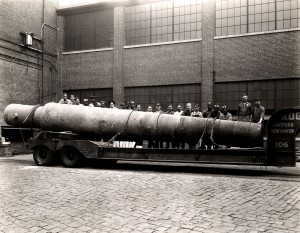 This photo is of Farrel Company workers, ca. 1940s (World War II period).
This photo is of Farrel Company workers, ca. 1940s (World War II period).
 UConn Library
Archives and Special Collections Blog
UConn Library
Archives and Special Collections BlogThe Penn Libraries’ Children’s Book Symposium Creating Children’s Books: Collaboration and Change will take place in conjunction with two fall exhibitions in the University of Pennsylvania Libraries. The exhibitions are “As the Ink Flows: Works from the Pen of William Steig” which will explore the life and career of the artist, cartoonist, and children’s book author/illustrator William Steig, and “The School of Atha: Collaboration in the Making of Children’s Books” which celebrates the life and work of Atha Tehon, children’s book designer and longstanding Art Director for Dial Books for Young Readers. The symposium will be held on October 17-18, 2014. For more information and the registration form, go to www.library.upenn.edu/exhibits/childrensbooks_symposium.html.

Looking at Layers
A picture book starts with a great story told in words (and in the sound of words read out loud). Illustrations accompany the author’s story. In the best picture books, the illustrations actually expand the story. The adult reader, as well as the child listening, feast visually on these layers that enrich the text in delightful and often unexpected ways.
As a picture book author, I focus my drafting and revision efforts on the story I want to tell. An illustrator’s considerable contribution to the final product most often comes long after I am done with my personal revision process (and any revisions guided by an acquiring editor). The publisher’s editor and art director usually select, guide, and supervise the artist. So the illustrator’s role seems a bit remote to me as I ply my craft. But remembering that layers can and should be added via art will help me create opportunities for an illustrator to deepen and expand my stories.
As I study the NCLC author/illustrator archives, I am examining the layering of art in picture books created by author/illustrators, whose creative talents allow them to tackle the words and art together. Author/illustrators don’t forget to leave room for layers—they create them as the picture book progresses in a unified way. They revise both words and illustrations to create balance and get it “just right.”
What does one find in the layers added to a picture book by illustration? Here are some thoughts, based on examples from author/illustrator archival material.
Emotion
Anita Riggio writes and illustrates from the heart. Emotion is the starting point for her wonderful stories. In Smack Dab in the Middle, Rosie Roselli is “smack dab in the middle” of her large, busy Italian family. Her many joyful accomplishments at school are ignored when she tries to share them at home, and she starts to wonder if maybe she isn’t the center of her loving family universe after all.
As I reviewed Anita’s process for Smack Dab in the Middle, I studied the text and illustrations on each spread, comparing what each separately communicates to readers. A particularly touching spread contains these words on page 20:
Rosie Roselli
really needed a hug.
She needed a hug
right this minute,
but her mother’s arms
were full of Rosie’s sister.
Rosie Roselli couldn’t wait.
She stepped up close.
She breathed in.
Talcum powder
and lavender water.
It smelled like a hug.
But it didn’t feel
like one.
Then and there,
Rosie Roselli decided
just want she
must do.
Anita’s evocative words tell us of Rosie’s need; they give the reader an expanded sense of story by dwelling on the scents (which can’t be illustrated) that she associates with her mother.
The related illustration (see below) shows Rosie’s mom’s back turned; she is attending to Rosie’s sister. Rosie’s head is bowed, her eyes are closed. The text doesn’t say, “Rosie felt disappointed, ignored, and rejected.” Those emotions are flowing from the illustration, creating a strong emotional layer to add to and support the text. (Even Anita’s placement of text and art emphasize Rosie’s loneliness here; the text snakes down the left page of this spread; there is empty space continuing onto the right page, where mom is facing away, almost out of the picture at the far right margin.)
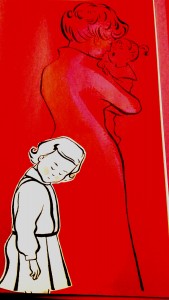 Riggio, Anita. Smack Dab In the Middle! (New York: G.P. Putnam’s Sons, 2002), 21. Photo taken from CLDC776, Archives and Special Collections at the Thomas J. Dodd Research Center, University of Connecticut Libraries.
Riggio, Anita. Smack Dab In the Middle! (New York: G.P. Putnam’s Sons, 2002), 21. Photo taken from CLDC776, Archives and Special Collections at the Thomas J. Dodd Research Center, University of Connecticut Libraries.
Plot expansion
Sometimes, illustrations take readers to places not even mentioned in the text. In Mabel the Tooth Fairy and How She Got Her Job, Katie Davis had some ideas about what might happen to a tooth fairy who works in the dark. The starting point for such an opportunity (to take the reader places) is text that is spare and full of possibilities. Here are three variations of a line of text Katie entertained (the third is final text):
After a few false starts, Mabel was considered an expert in the field.
After a few false starts, Mabel got to really like her work.
Working in the dark presented its own challenges.
All text versions support the three scenes shown below, although the final version perhaps is the funniest, with its spare understatement. The illustrations show the tooth fairy being accosted by the household mutt, slipping and falling on spilled “marbles,” and making noise by stepping on a toy horn.
The pictures transport the reader; the text does not say, “The dog of the house attacked me. I stumbled over a jar of spilled eyeballs…” Another whole layer of action/plot (with humor—the marble jar reads, “Slimy Eyeball Game”) has been added to the story through these illustrations.
Davis, Katie. Mabel the Tooth Fairy and How She Got Her Job (Orlando: Harcourt, Inc., 2003), 16. Photo taken from CLCD1438, Archives and Special Collections at the Thomas J. Dodd Research Center, University of Connecticut Libraries.
Humor
Author/illustrator Tomie dePaola also shares humor via his illustrations. His creative process for Strega Nona Meets Her Match began with a handwritten story accompanied by parenthetical notes to his editor. In this picture book, Big Anthony (Strega Nona’s loyal lunk of an assistant) “defects” to work for the competition, Strega Amelia. When Strega Amelia is away and Big Anthony is left in charge, he messes up the magic big time. Tomie’s earliest draft includes pertinent text (italicized) as well as his illustration ideas set forth in parentheses:
Big Anthony was in charge! (Series of pictures showing Big Anthony reading instructions and making big mistakes on the Husband and Wife wheel – mismatched couples – confusing wart cream and hair restorer – hair falls out, warts increase.)
Things weren’t going too well. (Source:Tomie dePaola Papers Box 41:125K).
Tomie then created illustrations (see below example of mixing up wart cream and hair restorer) to develop the humor of Big Anthony’s bumbling efforts.
Illustration for Strega Nona Meets Her Match, folder 125Y, Box 41 of Tomie dePaola papers. All rights reserved. No reproduction of any kind allowed.
What is interesting, however, is that Tomie’s editor suggested adding text to provide more at this point in the story, explaining that “for read aloud purposes it was important to have a few words.” (Source: Letter from Margaret Frith, Tomie dePaola Papers: Box 41:125L). Ultimately, the spare text was revised as suggested, and lengthened to:
Big Anthony smiled. He was in charge.
The first day he ran the husband and wife machine backwards.
The second day he confused the wart cream with the hair restorer.
Things weren’t going well.
As an author, I suspect that this lengthier text is where I would start my writing process for the same story action. How else would a reader know of the funny mishaps I envision? One possibility would be to include brief illustration suggestions to go with spare text. However, unlike an author/illustrator, who can write such notes to him or herself or to the editor (as Tomie did), an author must tread carefully when making suggestions for art so as not to be directing or limiting the illustrator’s creativity.
The right balance of text and art is achieved on pages 21–23 of the published book (see below). The complexity of Tomie’s illustration panels benefit from the added text that helps communicate his intent and humor regarding Big Anthony’s bumbling. The added text also nicely paces the story, allowing the reader to dwell on these silly mishaps.
[text: Big Anthony smiled. He was in charge.]
[text: The first day he ran the husband-and-wife machine backward.]
[text: The second day he confused the wart cream with the hair restorer.]
dePaola, Tomie. Strega Nona Meets Her Match (New York: G.P. Putnam’s Sons, 1993), 21–23. Photo taken from CLDC776, Archives and Special Collections at the Thomas J. Dodd Research Center, University of Connecticut Libraries.
Authors as well as author/illustrators must be mindful that there is a balance to be found between the read-aloud component and the illustrations in a picture book. However, an author who writes minimal text (even though he or she has a vision for what an illustrator might add) may run the risk of creating a manuscript that seems too slight or unclear to an editor, or perhaps, to young readers who may need some words to decode illustrations.
Conclusion
As I write and revise stories, I’ll keep thinking about layers. I’ll remember that my words need not dwell on emotions that an artist can convey with illustrations. I will deepen stories by words that can’t be shown in the art. I’ll choose words that may give an illustrator opportunities to take my protagonist to places (literally) other than those I may have had in mind. And if I am writing “funny,” I’ll strive for spare text that will encourage a clever artist to add visual jokes and hyperbole. I shall have trust to let an illustrator help tell my story—so that “our” story will marry text and art in a truly memorable picture book.
About Janet Lawler:
A recipient of a 2014 Billie M. Levy Research grant, Janet Lawler of Farmington, CT, is studying the relationship between art and text in picture books at the Northeast Children’s Literature Collection. Through studying the work and process of author-illustrators, she hopes to better understand how a story’s text interfaces with the art. She is searching for a deeper comprehension of why the best picture books are those where the final product is “greater” than the sum of the parts (text + illustrations). She looks forward to applying knowledge gleaned from her research to her own work process as a children’s author.
Ms. Lawler’s picture books have been published by major and specialty publishers. Two have been Children’s Book of the Month Club main selections, and two have been licensed into the Scholastic Book Clubs. If Kisses Were Colors has been translated into Spanish, Japanese, Hebrew, and Korean. Her recent credits include Ocean Counting (National Geographic, 2013 (named a 2014 Outstanding Science Trade Book by the National Science Teachers Association)) and Love Is Real (HarperCollins, 2014). National Geographic will publish Rain Forest Colors in November of 2014.
What a fantastic time we had on Sept. 19 when Richard “Huck” Scarry II visited with his lovely daughter Olympia and folks from Random House (Jason Zamajtuk, Lydia Finn, and Heidi Kilgras). We were joined by representatives from the School of Fine Arts, the English Department, the UConn Foundation, and the Neag School of Education. Huck is on a tour to promote the reissue of his father’s book “Busy, Busy World.”
Everyone had a tour of the archives, looked at some of the Richard Scarry original illustrations, listened to a tape of Huck’s mother being interviewed by Richard Scarry’s art director Ole Risom, and had a wonderful dinner in the Reading Room. Thank you, Huck and everyone, for the visit.
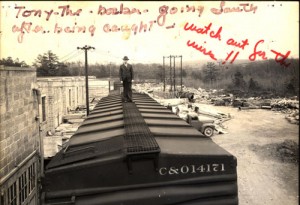
Photograph for documentation of an accident involving the conductor of the train and wiring above the cars, taken on April 18, 1947
This photograph was taken to document a train accident on an industrial siding in Dayville, Connecticut. Apparently the man standing on top of the freight car was there to show how the conductor of the train was injured when he came into contact with wiring. Someone amusingly wrote “Tony-the-hobo going South after being caught — watch out for the wires!!” on the print.
This print was recently donated by donor Edward J. Ozog.
[slideshow_deploy id=’1232′]
The winner for fiction is Andrew Smith, for Grasshopper Jungle; for nonfiction is Steve Sheinkin, for The Port Chicago 50: Disaster, Mutiny, and the Fight for Civil Rights; and for picture book, Peter Brown for Mr. Tiger goes Wild. The Honor Books winners in the fiction category are Elizabeth Wein, for Rose Under Fire and Gene Luen Yang for Boxers & Saints; for nonfiction, Steve Jenkins for The Animal Book: a Collection of the Fastest, Fiercest, Toughest, Cleverest Shyest – and Most Surprising – Animals on Earth and Patricia Hruby Powell for Josephine: the Dazzling Life of Josephine Baker;and for picture book, Daniel Beaty for Knock Knock: My Dad’s Dream for Me, and Shaun Tan for Rules of Summer. Congratulations to all!
Ethan Avery, a senior undergraduate student in history and political science, is a Student Library Assistant for Archives & Special Collections. Because of his academic concentration in (and general penchant for) the Early and High Middle Ages, Ethan took interest in the Medieval Fragments Collections. Below are his observations:
Stealing pages from medieval manuscripts has historically been a common practice due to value of even the individual pages. Most of these missing pages will fall into private collections or become lost after a short time. Fortunately, some of these pages return to archives, such as the pages that can be found in the Medieval Fragments Collection within Archives & Special Collections at the Thomas J. Dodd Research Center.
This collection was purchased in the early 1970s by the Special Collections division of the UConn library. It contains several pages from medieval manuscripts, showing beautiful calligraphy and artwork. These pages are primarily from the 15th century, but the earliest page was taken from a 13th century manuscript.
The purpose of the collection is to provide examples from the history of printing. These pages show the development of printing in France over the medieval period and are invaluable to the study of printing through the ages. But besides the aesthetic quality of the fragments, these pieces highlight the importance of collecting, preserving, and studying medieval manuscripts in the modern age. To view this fascinating collection, one simply has to visit Archives & Special Collections and request to use the Medieval Fragments Collection in the John P. McDonald Reading Room.
Blog Post 1: Author-Illustrators
As a writer, I confess to a long-held jealousy of the author/illustrator who gets to “play” with both parts of the picture book package, from idea through publication. I somehow had the idea (prejudice?) that creating a picture book is easier for these multi-talented people because they can “see” the whole project; the story (and related art) must just flow for them. I suspected that their process would not include the painstaking attention that I give to every word, and to every one of multiple variations of a story.
Although I have had several well-received picture books published, I continue to strive to improve my craft. I decided that a study of the process of author/illustrators might well help me better understand the magical interface of text and art that occurs in the best picture books. I hope my research helps improve my skill as a picture book writer, even if unlocking the secrets of author/illustrators can’t turn me into an artist.
Because I mostly write for the very young, I started my research with archival material of author/illustrator Katie Davis, who also writes for this audience. While I have only completed a review of two of her picture books, Kindergarten Rocks! and I Hate to Go to Bed!, I have already learned so much. And I have totally discarded my assumptions and prejudices.
Katie’s author/illustrator process is meticulous and time-consuming. For I Hate to Go to Bed! I studied twenty-seven dummies that Katie created. Each one included text revisions and illustration revisions, as she tweaked her story in major and minor ways. It appeared that many of these versions were done as part of her creative process before she came to the point where she was satisfied and ready to show a dummy to an editor. (I hope to interview Katie, to confirm this and ask other questions).
I now think that the author/illustrator’s job of writing a story may even be harder than mine because he or she thinks visually and can see so many possibilities.
Text and illustration revision of I Hate to Go to Bed! by Katie Davis
As a representative sample, here are several text revisions Katie played with for the opening spread of this book:
I hate to go to bed! This is because I’m a very outgoing person and I can’t stand the idea that I’m missing something. And I just know I’m missing something really fantastic.
I hate to go to bed. This is because I’m a very fun person and I can’t stand the idea that I’m missing something fun. And when I’m sent to bed, I just know I’m missing something really fantastic.
I hate to go to bed! My mama and daddy absolutely swear nothing good is happening and that I won’t miss anything but I’m not too sure.
I hate to go to bed! This is because I’m a very fun person and I just know I’m missing something really fantastic.
I hate to go to bed! Because I just know I’m missing something really fantastic.
I HATE to go to bed! I just KNOW I’m missing something.
I HATE to go to bed! I just know I’m missing something!
A study of the illustrations in these many dummies reveals a similar “visual” revision process. All of the dummies show a frowning little girl (Katie captured her protagonist immediately). Some of the earliest dummies show “thought bubbles” of her parents partying after she is asleep. Others show her room with piles of toilet paper rolls (from which she later makes binoculars for spying). In some, her matching fowl (ducks/chicks?) slippers are quipping back and forth.
Here are three examples of Katie’s many illustrations drawn for the opening spread of I Hate to Go to Bed! Click on each image to enlarge.
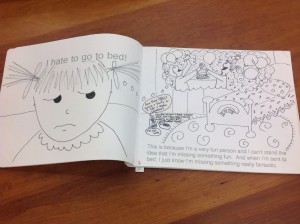
Opening spread of I Hate to Go to Bed!, 1st dummy in Box 4: Folder 15 of Katie Davis Papers. All rights reserved. No reproduction of any kind allowed.
A later version, with simplified text:
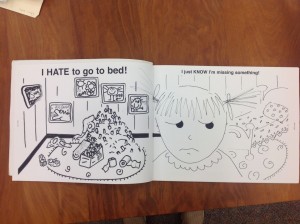
Opening spread of I Hate to Go to Bed!, 2nd dummy in Box 4: Folder 18 of Katie Davis Papers. All rights reserved. No reproduction of any kind allowed.
And the final opening spread found in the published book:
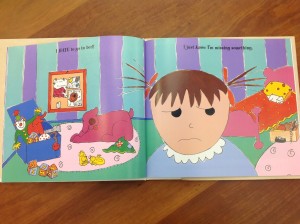
Davis, Katie. I Hate to Go to Bed! (New York: Harcourt Children’s Books, 1999), 4-5. Photo taken from : CLDC1438, Archives and Special Collections at the Thomas J. Dodd Research Center, University of Connecticut Libraries
The study of both text and illustrations reveals that Katie kept working the text and art, paring both to their essence. Her final version of the first spread immediately grabs a reader and sets the stage for the storyline to play out in a well-paced way over the rest of the book.
The frowning face of the determined protagonist remains almost identical throughout all versions of the first spread. Ultimately, that face, along with twelve words in two short sentences, clearly share her BIG problem with the reader.
Throughout the many variations of the remaining storyline, Katie explores different approaches, both with art and text, to reveal how her protagonist tackles and solves her dilemma. All versions include varied layers of meaning and humor. Sometimes, the same words, illustrated in different ways, change the plot and the story’s pacing.
How will what I’ve studied so far change my own process as an author?
I plan to slow my process down to focus more clearly on my story’s essence. I will try to pare text to get to the universal—the situation, emotion, or problem that every kid can relate to in my writing.
I hope slowing down will help me to imagine different ways the story arc might play out around the universal theme. I shall play “what if?” and “why not?” with my words in a way that will let an illustrator fill in blanks. I will strive to be less wedded to the “first” story I write; there may be other words or plot angles that offer more opportunities for an illustrator.
If I am to truly leave room for an illustrator, I need to focus even more on making every single word musical and meaningful.
Writers should make dummies as part of their process
To accomplish all of the above, or to strive to do so, I plan to create a dummy (for the text) for every story I write. I have done this with some of my manuscripts, but not all, since I have developed a good sense of story arc and appropriate length for a 32-page picture book. However, I believe parsing the text of each story I write, and placing it on the pages, will further improve my craft by encouraging me to 1) better examine what words belong on each page/spread, 2) consider whether my words allow for expansion of my story through different actions/illustrations, 3) improve forward plot motion and page turns,4) evaluate alternate story possibilities and pacing, and, just perhaps, 5) “see” more clearly how a better story might be told.
I can’t wait to start! And I can’t wait to continue my research!
[slideshow_deploy id=’1094′]
Archives & Special Collections is proud to announce that Ed Young, the multi-award winning author and illustrator of children’s books, has donated his extensive collection of artwork, sketches, scrolls, storyboards, color studies and other archival materials to the Northeast Children’s Literature Collection. Mr. Young was born in Tientsin, China, lived in Shanghai and Hong Kong, and moved to the United States in 1951 to study architecture. He graduated from the Art Center College of Design in Pasadena, California, and taught at the Pratt Institute, Yale University, Naropa Institute, and the University of California at Santa Cruz.
The awards and accolades for his books are too numerous to list but include the Caldecott Medal for Lon Po Po (1989) and Caldecott Honors for The Emperor and the Kite (1967) and Seven Blind Mice (1992). His books have been named to the ALA Notable Books list seven times, have been awarded the AIGA Award: The Fifty Most Beautiful Books of the Year ten times, and have received three Boston Globe Horn Book Honor Awards. Mr. Young was also nominated in 1992 and 2000 as the U.S. representative to receive the Hans Christian Andersen Award, for “works that have made a lasting contribution to children’s literature.” Some of Mr. Young’s best-known and most-loved books are derived from Chinese folktales and include The Sons of the Dragon King (2004); Monkey King (2001); The Lost Horse (1998); Mouse Match (1997); Night Visitors (1997); Little Plum (1994); Red Thread (1993); Seven Blind Mice (1992); The Voice of the Great Bell (1989); The Eyes of the Dragon (1986); Yeh Shen (1982); White Wave (1979); Cricket Boy (1977), and 8000 Stones (1971).
The Ed Young Papers have been on deposit in the Northeast Children’s Literature Collection for approximately eighteen years. His artwork travels extensively around the world for exhibitions, including many museums in this country as well as the European Union. Mr. Young employs various media such as collage, watercolor and pastel, making his collection a treasure trove for researchers in the fine arts. The finding aid for the Ed Young Papers provides information on the more than ninety books’ worth of archival materials. Mr. Young now lives in Westchester County, New York, with his family and a cat. More information on Ed Young is available at http://edyoungart.com/. The Northeast Children’s Literature Collection holds a substantial collection of materials pertaining to children’s literature and is very grateful for this extremely important addition.
Thank you, Mr. Young!
It happens with delightful frequency that historical treasures find their way to our archives in round-about ways. Last week I received a call from UConn history professor Christopher Clark, who had been contacted by a woman in Texas who owned a letter that had a connection to eastern Connecticut. Dr. Clark put me in touch with Ms. Anne Bowbeer of San Antonio, who described the letter and asked if I would like to include it in the archive. I most certainly would!
![Letter from S. Hitchcock of Reidsville [possibly North Carolina] to Michael Richmond of Windham County, Connecticut, August 13, 1835](https://blogs.lib.uconn.edu/archives/files/2014/08/2014-0113_ms1.jpg)
Letter from S. Hitchcock of Reidsville [possibly North Carolina] to Michael Richmond of Windham County, Connecticut, August 13, 1835
Reidsville August 13th A.D. 1835
My dear Sir I expected to have written to you, long before this time. But in consequence of the plentiful harvest and few Labourers in this region I have delayed writing till now. By letter received from Connecticut I have understood that my temporal concerns required that I should once more journey to my native town. And as any field of labour in this Country is verry extensive; and my whole time devoted to religious service I have waited [for] the vacancy of a fifth Sabbath that I might consistently[?] leave my circuit for a few days; you may therefore expect (If the Lord will) me to attend meeting at your Meeting house on the fifth Sunday in August at the usual hour of meeting. You are therefore at liberty to make the appointment if you think it best. I greatly desire your prosperity as a free religious; people had[?] should have much to write; But as I hope soon to see you face to face I defer writing more. Serve the Lord and Fare Well. Your Respectfully S. Hitchcock.
The letter brings up a lot of questions — who was S. Hitchcock? What led him to leave Connecticut? Who was Michael Richmond?
Perhaps an inquisitive student from the region will choose to research these men and their place in history. For now we’re grateful to Ms. Bowbeer for her thoughtful decision to send the letter to us and allow us to save it for another 180 years and beyond.
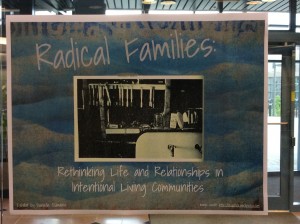 Communes, especially the communities that arose in the United States in the 1960s and 1970s, occupy a particular place in popular culture. Films, movies, novels, and public memory have provided a particular rendering of the experiences, relationships, and motivations that drove people “back to the land” as part of the larger cultural, political, and social shifts of the post-war period. But how did the members of these communities define their experiences? What did it look like to live in these spaces? Using materials from the Alternative Press Collection and the Diane di Prima papers, this exhibit seeks to offer a visual record of daily activities on a variety of communities; religious, political or otherwise, that will challenge or confirm viewers understanding of communal living. More specifically, these photos and documents focus on family life in these spaces. What did it look like to be part of a family in an intentional living community? How were mid-century ideas of motherhood, fatherhood, and generational boundaries and knowledge questioned, reinforced, or redefined. By asking these questions viewers will hopefully gain a richer portrait of what it meant to live and grow in these radical spaces and how these communities fit in to a longer history of the family and of communal living in the United States.
Communes, especially the communities that arose in the United States in the 1960s and 1970s, occupy a particular place in popular culture. Films, movies, novels, and public memory have provided a particular rendering of the experiences, relationships, and motivations that drove people “back to the land” as part of the larger cultural, political, and social shifts of the post-war period. But how did the members of these communities define their experiences? What did it look like to live in these spaces? Using materials from the Alternative Press Collection and the Diane di Prima papers, this exhibit seeks to offer a visual record of daily activities on a variety of communities; religious, political or otherwise, that will challenge or confirm viewers understanding of communal living. More specifically, these photos and documents focus on family life in these spaces. What did it look like to be part of a family in an intentional living community? How were mid-century ideas of motherhood, fatherhood, and generational boundaries and knowledge questioned, reinforced, or redefined. By asking these questions viewers will hopefully gain a richer portrait of what it meant to live and grow in these radical spaces and how these communities fit in to a longer history of the family and of communal living in the United States. 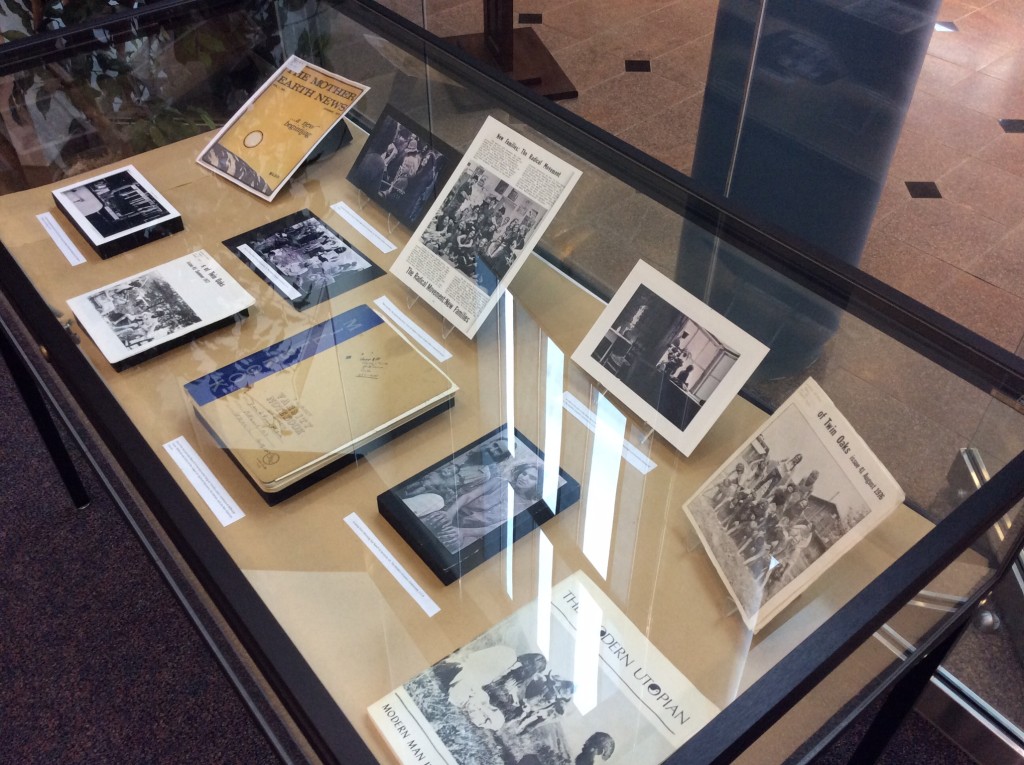
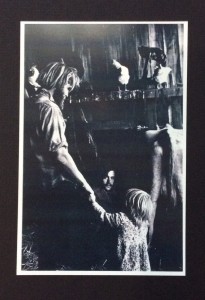
This exhibit was curated by Graduate Student Intern Danielle Dumaine. It will be on display in the John P. McDonald Reading Room, Archives and Special Collections at the Thomas J. Dodd Research Center until the end of September.
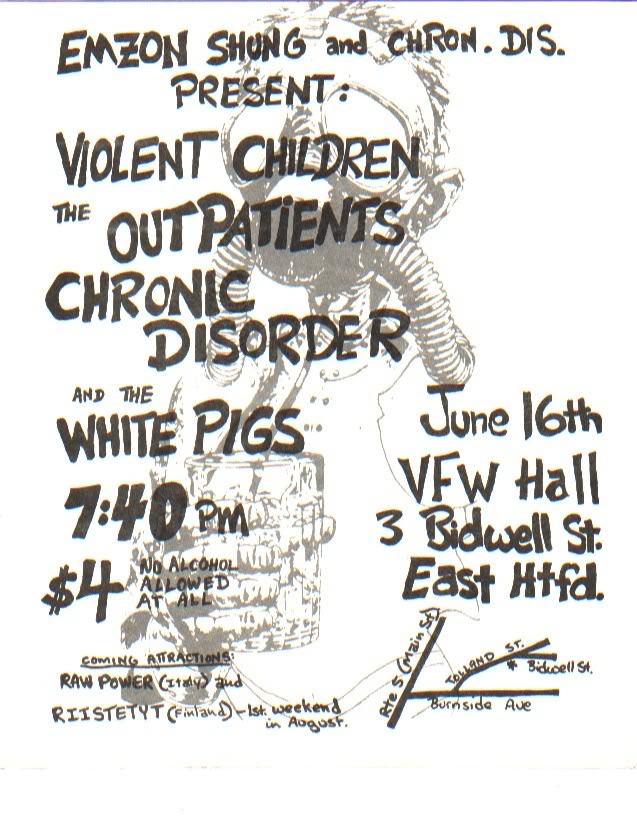
2013-0052_gm030 Emzon Shung and Chron.Dis. Present, Box 1 Folder 1. Joe Snow Punk Rock Collection, Archives and Special Collections, Thomas J. Dodd Research Center at the University of Connecticut.
This summer, Research Assistant of Digital Media & Design Clarissa Ceglio and Archivist Graham Stinnett will be co-teaching two courses on Digital Humanities and Archives. The courses are for junior’s in high school intended to provide them with early education in University tools and resources such as libraries, archives and digital instruction. The course will focus its primary source work on the Joe Snow Punk Rock Collection at the Archives & Special Collections, where students will have a first hand experience with punk flyers, posters, stickers, pins and ephemera within the collection. Students will benefit from a behind the scenes experience with historical records and artifacts in an archives to prepare them for future research access in an academic setting. The archival experience will then be extended into the digital realm, where students will construct portals for digital content and description and analysis of primary resources on the web. Students will learn about techniques for manipulating digital content and interface tools to build contextual digital media pages. Providing students the opportunity to engage in archival resources at an early age promotes further investigation into historical documents as education and research continues at the University level and beyond.